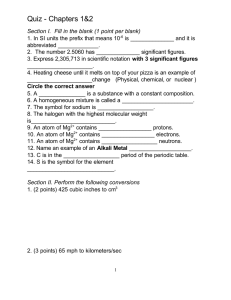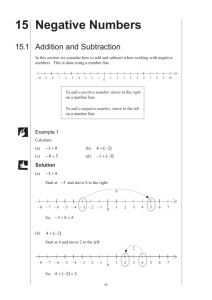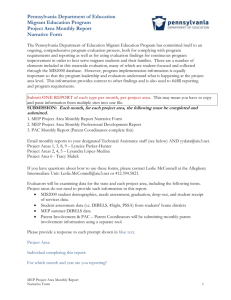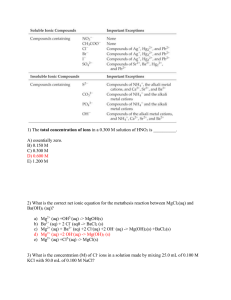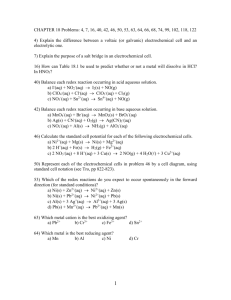Kinetic and Mechanistic Analysis of Nonenzymatic, Template-Directed Oligoribonucleotide Ligation
advertisement
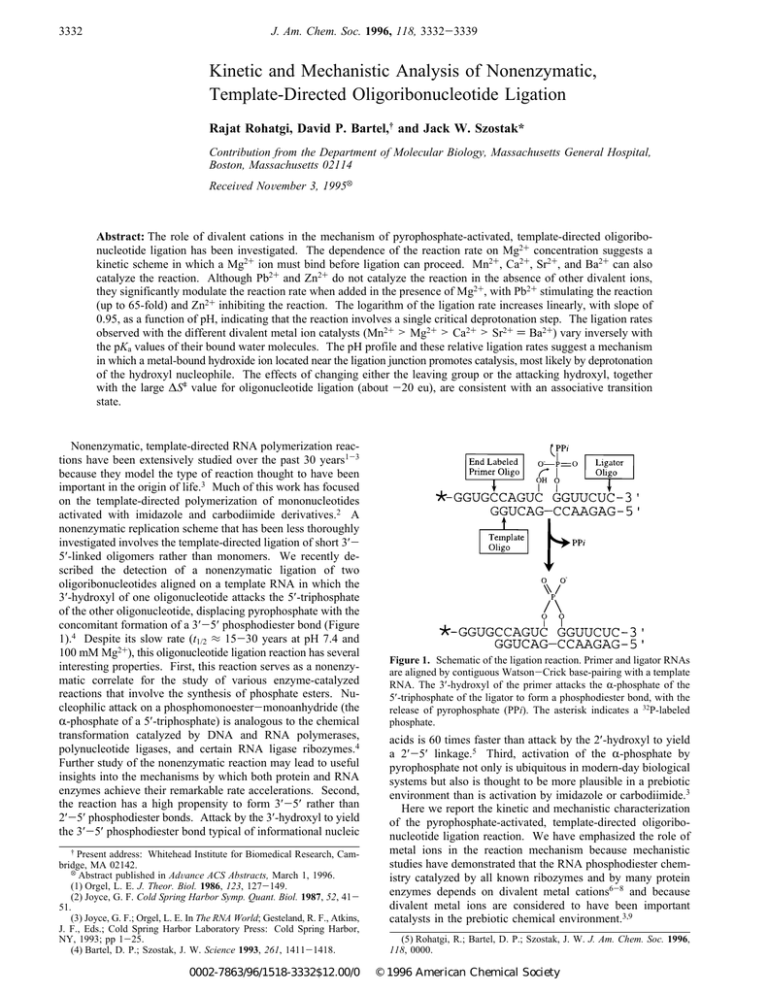
3332
J. Am. Chem. Soc. 1996, 118, 3332-3339
Kinetic and Mechanistic Analysis of Nonenzymatic,
Template-Directed Oligoribonucleotide Ligation
Rajat Rohatgi, David P. Bartel,† and Jack W. Szostak*
Contribution from the Department of Molecular Biology, Massachusetts General Hospital,
Boston, Massachusetts 02114
ReceiVed NoVember 3, 1995X
Abstract: The role of divalent cations in the mechanism of pyrophosphate-activated, template-directed oligoribonucleotide ligation has been investigated. The dependence of the reaction rate on Mg2+ concentration suggests a
kinetic scheme in which a Mg2+ ion must bind before ligation can proceed. Mn2+, Ca2+, Sr2+, and Ba2+ can also
catalyze the reaction. Although Pb2+ and Zn2+ do not catalyze the reaction in the absence of other divalent ions,
they significantly modulate the reaction rate when added in the presence of Mg2+, with Pb2+ stimulating the reaction
(up to 65-fold) and Zn2+ inhibiting the reaction. The logarithm of the ligation rate increases linearly, with slope of
0.95, as a function of pH, indicating that the reaction involves a single critical deprotonation step. The ligation rates
observed with the different divalent metal ion catalysts (Mn2+ > Mg2+ > Ca2+ > Sr2+ ) Ba2+) vary inversely with
the pKa values of their bound water molecules. The pH profile and these relative ligation rates suggest a mechanism
in which a metal-bound hydroxide ion located near the ligation junction promotes catalysis, most likely by deprotonation
of the hydroxyl nucleophile. The effects of changing either the leaving group or the attacking hydroxyl, together
with the large ∆Sq value for oligonucleotide ligation (about -20 eu), are consistent with an associative transition
state.
Nonenzymatic, template-directed RNA polymerization reactions have been extensively studied over the past 30 years1-3
because they model the type of reaction thought to have been
important in the origin of life.3 Much of this work has focused
on the template-directed polymerization of mononucleotides
activated with imidazole and carbodiimide derivatives.2 A
nonenzymatic replication scheme that has been less thoroughly
investigated involves the template-directed ligation of short 3′5′-linked oligomers rather than monomers. We recently described the detection of a nonenzymatic ligation of two
oligoribonucleotides aligned on a template RNA in which the
3′-hydroxyl of one oligonucleotide attacks the 5′-triphosphate
of the other oligonucleotide, displacing pyrophosphate with the
concomitant formation of a 3′-5′ phosphodiester bond (Figure
1).4 Despite its slow rate (t1/2 ≈ 15-30 years at pH 7.4 and
100 mM Mg2+), this oligonucleotide ligation reaction has several
interesting properties. First, this reaction serves as a nonenzymatic correlate for the study of various enzyme-catalyzed
reactions that involve the synthesis of phosphate esters. Nucleophilic attack on a phosphomonoester-monoanhydride (the
R-phosphate of a 5′-triphosphate) is analogous to the chemical
transformation catalyzed by DNA and RNA polymerases,
polynucleotide ligases, and certain RNA ligase ribozymes.4
Further study of the nonenzymatic reaction may lead to useful
insights into the mechanisms by which both protein and RNA
enzymes achieve their remarkable rate accelerations. Second,
the reaction has a high propensity to form 3′-5′ rather than
2′-5′ phosphodiester bonds. Attack by the 3′-hydroxyl to yield
the 3′-5′ phosphodiester bond typical of informational nucleic
† Present address: Whitehead Institute for Biomedical Research, Cambridge, MA 02142.
X Abstract published in AdVance ACS Abstracts, March 1, 1996.
(1) Orgel, L. E. J. Theor. Biol. 1986, 123, 127-149.
(2) Joyce, G. F. Cold Spring Harbor Symp. Quant. Biol. 1987, 52, 4151.
(3) Joyce, G. F.; Orgel, L. E. In The RNA World; Gesteland, R. F., Atkins,
J. F., Eds.; Cold Spring Harbor Laboratory Press: Cold Spring Harbor,
NY, 1993; pp 1-25.
(4) Bartel, D. P.; Szostak, J. W. Science 1993, 261, 1411-1418.
0002-7863/96/1518-3332$12.00/0
Figure 1. Schematic of the ligation reaction. Primer and ligator RNAs
are aligned by contiguous Watson-Crick base-pairing with a template
RNA. The 3′-hydroxyl of the primer attacks the R-phosphate of the
5′-triphosphate of the ligator to form a phosphodiester bond, with the
release of pyrophosphate (PPi). The asterisk indicates a 32P-labeled
phosphate.
acids is 60 times faster than attack by the 2′-hydroxyl to yield
a 2′-5′ linkage.5 Third, activation of the R-phosphate by
pyrophosphate not only is ubiquitous in modern-day biological
systems but also is thought to be more plausible in a prebiotic
environment than is activation by imidazole or carbodiimide.3
Here we report the kinetic and mechanistic characterization
of the pyrophosphate-activated, template-directed oligoribonucleotide ligation reaction. We have emphasized the role of
metal ions in the reaction mechanism because mechanistic
studies have demonstrated that the RNA phosphodiester chemistry catalyzed by all known ribozymes and by many protein
enzymes depends on divalent metal cations6-8 and because
divalent metal ions are considered to have been important
catalysts in the prebiotic chemical environment.3,9
(5) Rohatgi, R.; Bartel, D. P.; Szostak, J. W. J. Am. Chem. Soc. 1996,
118, 0000.
© 1996 American Chemical Society
Template-Directed Oligoribonucleotide Ligation
Experimental Section
Reagents. Unlabeled nucleoside triphosphates were purchased from
Pharmacia, ribonucleoside phosphoramidites were from ChemGenes,
and [γ-32P]ATP and the Rp and Sp isomers of [R-S]GTP were from
NEN. T7 RNA polymerase was from USB, T4 polynucleotide kinase
was from New England Biolabs, calf intestinal alkaline phosphatase
was from Boehringer Mannheim, and RNasin RNase inhibitor was from
Promega. Buffers (BES, Tris, CHES, and Bis-Tris propane) were
purchased from Sigma. All metal salts were purchased from Aldrich
and were of the highest purity available: MgCl2 (99.995%), MnCl2
(99.99%), CaCl2 (99.99+%), SrCl2 (99.995%), BaCl2 (99.999%),
Pb(CH3CO2)2 (99.999%), ZnCl2 (99.999%), CuCl2 (99.9%), KCl
(99.98%), and KOAc (99+%).
RNA Synthesis and Purification. The 13-nt template RNA (5′GAGAACCGACUGG-3′) was chemically synthesized using ribonucleoside phosphoramidites on a Millipore Expedite nucleic acid
synthesizer. The synthetic RNA was deprotected using 3:1 aqueous
NH4OH/CH3CH2OH for 12 h at 55 °C. The supernatant was removed,
passed through a 0.2 µm filter to remove CPG particles, and dried under
vacuum. The resulting solid was resuspended with sonication in 700
µL of 1 M tetrabutylammonium fluoride (TBAF) in THF (Aldrich).
After incubation for 2-3 days at room temperature in the dark, 700
µL of a 1:1 H2O/CH3CN solution with 150 mM NH4OAc was added,
and the RNA purified by HPLC on a preparative scale anion exchange
column (Dionex NucleoPac), using aqueous ammonium acetate/10%
acetonitrile as the eluent.
The 10-nt primer RNA and the 7-nt ligator RNA (Figure 1) were
prepared by run-off transcription from synthetic DNA oligonucleotides,10 purified on 20% polyacrylamide/8 M urea gels (1.2 mm thick,
40 cm long), and eluted from the gels by the crush and soak method
in 0.3 M NaOAc. (Ligation rates did not change when chemically
synthesized primer was substituted for enzymatically synthesized
primer.) Chemically synthesized primer was 5′-end-labeled using T4
polynucleotide kinase and 100 µCi of [γ-32P]ATP. Enzymatically
synthesized primer was dephosphorylated with calf alkaline phosphatase
and purified on 20% polyacrylamide/8 M urea gel prior to 5′-endlabeling. The 5′-end-labeled primers were phenol extracted three times,
chloroform extracted, and ethanol precipitated.
To facilitate synthesis of GDP- and [R-S]GTP-substituted ligator
RNAs, the ligator sequence was redesigned to have a unique guanosine
residue at the 5′ end (5′-GCUCCU-3′), and the template was concurrently changed (5′-AGGAGCGACUGG-3′). These changes did not
alter the base pairs immediately flanking the ligation junction. The
GDP- and [R-S]GTP-substituted ligators were synthesized enzymatically
by replacing GTP with either GDP or [R-S]GTP in the transcription
reactions.
Ligation Reaction. Reactions were performed in 10 µL volumes
with 0.4 µM 5′-end-labeled primer, 2.5 µM template, 3 µM ligator,
200 mM KCl, 50 mM buffer at the indicated pH, and the indicated
divalent cation. The buffers used were BES (pH 6.4-7.8), Tris (pH
7.3-8.8), CHES (pH 8.6-10.0), and Bis-Tris propane (pH 6.3-9.5).
All pH values given have been adjusted for the temperature and other
reaction components. Unless otherwise noted, all reactions were
incubated at 37 °C in a circulating air incubator for time periods ranging
from 12 to 100 h. All metals except Pb2+ were used as their chloride
salts; since PbCl2 is insoluble, these reactions were performed with
Pb(OAc)2; KOAc also replaced KCl. Substitution of KOAc for KCl
did not affect ligation rates with any of the divalent cations. At each
pH value, the rates were measured using at least two different buffers
and did not significantly change with the identity of the buffer.
All reactions were stopped by adding an equal volume of 200 mM
EDTA, 8 M urea, 0.02% xylene cyanol, and 0.05% bromphenol blue,
followed by freezing at -80 °C. Reaction products were separated
from reactants on 20% polyacrylamide/8 M urea gels (0.4 mm thick
(6) Pan, T.; Long, D. M.; Uhlenbeck, O. C. In The RNA World; Gesteland,
R. F., Atkins, J. F., Eds.; Cold Spring Harbor Laboratory Press: Cold Spring
Harbor, NY, 1993; pp 271-302.
(7) Pyle, A. M. Science 1993, 261, 709-714.
(8) Yarus, M. FASEB J. 1993, 7, 31-39.
(9) Joyce, G. F. Nature 1989, 338, 217-224.
(10) Milligan, J. F.; Groebe, D. R.; Witherell, G. W.; Uhlenbeck, O. C.
Nucleic Acids Res. 1987, 15, 8783-8798.
J. Am. Chem. Soc., Vol. 118, No. 14, 1996 3333
and 40 cm long). Radioactivity was quantitated using a Molecular
Dynamics PhosphorImager.
Kinetic Analysis. In the time ranges examined (e100 h), the
fraction of labeled primer converted to product was a linear function
of time. Since oligonucleotide ligation is a pseudo-first-order process,
the slope of such a plot is equal to kobs, the pseudo-first-order rate
constant. The hyperbolic saturation curves obtained from Mg2+
concentration courses were fit to Michaelis-Menten type equations
that assume a single Mg2+ binding site. The following kinetic scheme
was used:
K′
k1
ligation complex + Mg2+ {\} Mg2+ bound complex 98
ligated product
The ligation complex is the ligator-primer-template double helical
complex (Figure 1). Since k1 is almost certainly very slow in
comparison to the rate of breakdown of the Mg2+ bound complex, Mg2+
binding can be assumed to be at equilibrium, with K′ as the equilibrium
constant. Michaelis-Menten type analysis11 leads to the following
equation:
kobs )
k1[Mg2+]
ligation rate
)
[ligation complex]o K′ + [Mg2+]
(1)
In the text, [Mg2+]1/2 (the Mg2+ concentration at which kobs is halfmaximal) refers to K′.
Temperature Dependence of the Ligation Rate. Reactions were
performed beneath a mineral oil overlay in 10 µL volumes containing
0.4 µM 5′-end-labeled primer, 2.5 µM template, 3 µM ligator, 200 mM
KCl, 100 mM Mg2+, and 50 mM CHES, pH 8.9. The buffer pH was
adjusted to account for the effect of temperature on pH. Each rate
was determined at least twice in independent experiments and averaged;
k1 values were derived using eq 1 shown above. The Eyring equation
used for the determination of activation parameters is as follows:12
k1 ) [kbT/h] exp[-∆Hq/(RT)] exp[∆Sq/R]
(2)
kb is the Boltzmann constant, h is the Planck constant, R is the universal
gas constant, and T is the absolute temperature.
Data Analysis. The data were analyzed using KaleidaGraph
(Abelbeck Software). Due to the low rate of the reaction, long
incubation times (up to 100 h) were required, and the variability between
data obtained from experiments set up on different days using different
reaction mixes was considerable (usually ranging from -50% to
+100%). Reactions set up on the same day with the same reaction
mixes were more reproducible ((20%). All error values are standard
error values based on the nonlinear least-squares fit of the observed
data to theoretical equations.
Results
Effects of pH and Divalent Metal Cations. We examined
a template-directed oligonucleotide ligation in which a 13-nt
template RNA aligns, by contiguous Watson-Crick basepairing, a 10-nt primer RNA in juxtaposition with a 7-nt ligator
RNA (Figure 1). The 3′-hydroxyl of the primer attacks the 5′triphosphate of the ligator to generate the 17-nt ligation product,
with release of pyrophosphate. All reactions included 5′-endlabeled primer at a concentration of 0.4 µM, and sufficient
template and ligator (2.5 and 3 µM, respectively) to ensure that
essentially all of the primer was in a primer-template-ligator
complex. Increasing the template and ligator concentrations to
30 and 50 µM, respectively, had no effect on the rate at
temperatures ranging from 0 to 37 °C, pH values ranging from
6.5 to 9.0, and Mg2+ concentrations ranging from 10 to 600
(11) Fersht, A. Enzyme Structure and Mechanism; W.H. Freeman and
Co.: New York, 1985.
(12) Lowry, T. H.; Richardson, K. S. Mechanism and Theory in Organic
Chemistry, 3rd ed.; HarperCollins Publishers: New York, 1987; pp 202211.
3334 J. Am. Chem. Soc., Vol. 118, No. 14, 1996
Figure 2. Representative time course of the ligation reaction. (A) An
autoradiogram of a denaturing 20% polyacrylamide gel used to separate
labeled primer from the ligation product. The gel shows a time course
of the ligation reaction performed in 100 mM Mg2+ at pH 9.0. (B) The
fraction of primer converted to product is a linear function of time in
the time ranges used throughout this study. The slope of this plot (kobs)
is 2.1 × 10-5 h-1.
Figure 3. pH dependence of kobs. The slope of the best-fit line to data
points between pH 6.5 and pH 9.0 is 0.95. Reactions were performed
at 37 °C using 100 mM Mg2+ and BES, Tris, or CHES buffer.
mM (data not shown). This confirmed that the template and
ligator concentrations used throughout this study were sufficiently above the Kd of the primer-ligator-template complex
to yield a pseudo-first-order process. A representative time
course of the oligonucleotide ligation reaction is shown in Figure
2.
The ligation rate was measured as a function of pH (Figure
3). A plot of the logarithm of kobs against pH is linear, with a
slope of 1.0, between pH 6.5 and 9.0. The ligation rate did not
vary with changes in buffer concentration or with the identity
of the buffer. Above pH 9.2, ligation rates were slower than
predicted from extrapolation of rates at lower pH values (Figure
3). This leveling off is probably a result of the disruption of
Rohatgi et al.
Figure 4. kobs as a function of Mg2+ concentration at pH 7.0 (squares),
pH 7.8 (triangles), and pH 8.9 (circles). The lines shown are the
nonlinear least-squares fits of Michaelis-Menten curves to the data.
Extracted values for k1 and [Mg2+]1/2 are as follows: pH 7.0, k1 ) (1.1
( 0.1) × 10-5 h-1, [Mg2+]1/2 ) 150 ( 40 mM; pH 7.8, k1 ) (9.0 (
1.0) × 10-5 h-1, [Mg2+]1/2 ) 284 ( 74 mM; pH 8.9, k1 ) (4.1 ( 0.5)
× 10-4 h-1, [Mg2+]1/2 ) 253 ( 48 mM.
the double helix resulting from the deprotonation of guanosine
(N1, pKa ) 9.4) and uridine (N3, pKa ) 9.4) residues.13 Above
pH 9.2, the rate of nonspecific degradation also sharply increased
(data not shown). This is consistent with the disruption of the
double helix because single-stranded RNA is much more
susceptible to base hydrolysis than is double-stranded RNA.5,13,14
A similar plateauing of cleavage rate at pH g 9.0 is observed
with the hammerhead ribozyme and has also been attributed to
the disruption of base-pairing.15 The pH-rate profile shown
in Figure 3 was performed at subsaturating Mg2+ concentrations
(100 mM) because rates could not be reliably measured at
saturating concentrations. At these higher concentrations,
nonspecific RNA hydrolysis becomes particularly severe and
limits reproducibility.15-17
Plots of kobs against the Mg2+ concentration (Figure 4) are
consistent with a single, saturable Mg2+ binding site4 (but see
below for further discussion of this point). Ligation was
undetectable in the absence of Mg2+ even though the reactions
contained 200 mM KCl to stabilize the RNA double helix.
Addition of 10 mM spermidine did not alleviate the Mg2+
requirement. At 100 mM Mg2+, the omission of KCl had no
effect on the ligation rate (data not shown). The effects of pH
and Mg2+ seem to be independent; at three different pH values,
the [Mg2+]1/2 values are in the same range (150-280 mM)
(Figure 4).
We then examined a series of divalent metal cations for their
ability to substitute for Mg2+, Mn2+, Ca2+, Ba2+, and Sr2+ could
promote ligation in the absence of Mg2+ (Figure 5). However,
Pb2+, Zn2+, and Cu2+ were not active in the concentration and
pH ranges tested. Ligation was also not catalyzed by either
the [UO2]2+ ion (1-10 mM, pH 7.0) or Montmorillonite clay
(13) Saenger, W. Principles of Nucleic Acid Structure; SpringerVerlag: New York, 1984; pp 201-219.
(14) Farkas, W. R. Biochim. Biophys. Acta. 1968, 155, 401-409.
(15) Dahm, S. C.; Derrick, W. B.; Uhlenbeck, O. C. Biochemistry 1993,
32, 13040-13045.
(16) Butzow, J. J.; Eichorn, G. L. Biopolymers 1965, 3, 95-107.
(17) Behlen, L. S.; Sampson, J. R.; DiRenzo, A. B.; Uhlenbeck, O. C.
Biochemistry 1990, 29, 2515-2523.
Template-Directed Oligoribonucleotide Ligation
Figure 5. Effects of substituting Mg2+ with a series of divalent cations.
(A, top) Change in kobs as a function of Mg2+ (circles) and Mn2+
(squares) concentrations at pH 7.0. The values of k1 for the Mg2+ and
Mn2+ reactions are (1.1 ( 0.1) × 10-5 h-1 and (1.2 ( 0.4) × 10-4
h-1, respectively. (B, bottom) Change in kobs as a function of Mg2+
(diamonds), Ca2+ (squares), Sr2+ (triangles), and Ba2+ (circles) concentrations at pH 8.7.
(50 mg/mL, pH 7.0), both of which effectively promote the
polymerization of adenosine 5′-phosphorimidazolides.18,19
A variety of factors limited the pH and concentration ranges
under which reproducible data on the catalytic efficiency of these
metal ions could be obtained. Pb2+ and the transition metal
ions promote the rapid degradation of RNA at pH values above
7.5.6,14,16 Under our reaction conditions, relatively low concentrations (∼20 mM) of Pb2+, Fe2+, Cu2+, and Mn2+ almost
completely degraded the RNA at pH values above 7.8 (data
not shown). These ions also form insoluble hydroxides much
more readily than the alkaline earth metals at pH values above
7.0, potentially reducing the free metal ion concentration as well
as precipitating the RNA.15,17,20,21 Finally, the transition metal
(18) Shimazu, M.; Shinozuka, K.; Sawai, H. Angew. Chem., Int. Ed. Engl.
1993, 32, 870-872.
(19) Ferris, J. P.; Ertzem, G. Science 1992, 257, 1387-1389.
(20) Kragten, J. Atlas of Metal-Ligand Equilibria in Aqueous Solution;
Halsted Press: Chichester, England, 1978.
(21) Westermann, K.; Naser, K. H.; Brandes, G. Inorganic Chemistry,
12th ed.; VEB Deutscher Verlag fur Grundstoffindustrie: Leipzig, Germany,
1986; pp 53-55.
J. Am. Chem. Soc., Vol. 118, No. 14, 1996 3335
ions readily react with dissolved oxygen at higher pH values to
form metal oxides.15,20,21 Because of these limitations, Mn2+
and Pb2+ were used only at pH values below 7.5, and Zn2+
below pH 8.3. In addition, we were only able to use Pb2+ at
concentrations of e15 mM, Zn2+ at e50 mM, and Mn2+ at
e200 mM.
At pH 7.0, the Mn2+-catalyzed rate was 5-7 times faster
than the rate at the equivalent concentration of Mg2+ (Figure
5A). Although the rate at saturating metal ion concentrations
could not be measured directly, curves fitted to the data suggest
that the rate at saturating Mn2+ concentrations (k1) is ∼10-fold
higher than the rate at saturating Mg2+ concentrations. The
catalytic efficiency of Mg2+ was compared to that of Ca2+, Sr2+,
and Ba2+ at pH 8.7 (Figure 5B). At a concentration of 250
mM, which appears to be close to saturation for all four metal
ions, the Mg2+-catalyzed rate was ∼8-13 times faster than the
Ca2+-catalyzed rate and ∼45-50 times faster than the Ba2+and Sr2+-catalyzed rates. The catalytic efficiencies of these
divalent cations can therefore be ordered as follows: Mn2+ >
Mg2+ > Ca2+ > Ba2+ ) Sr2+.
Pb2+ and Zn2+ were added to the ligation reaction in the
presence of Mg2+. Whereas Zn2+ markedly inhibited the
reaction (Figure 6A), Pb2+ was an extremely efficient cocatalyst
(Figure 6B). When 10 mM Pb2+ was included, the ligation
rate at pH 7.3 was ∼65-fold faster than the rate with 100 mM
Mg2+ alone. In the presence of Pb2+, the reaction still displayed
saturation kinetics for Mg2+; however, the [Mg2+]1/2 for the
reaction was reduced from ∼250 to ∼20 mM (Figure 6C). k1
was also increased in the presence of Pb2+, and this effect could
not be competed away by Mg2+ concentrations as high as 300
mM.
Activation Parameters for Oligonucleotide Condensation.
A Michaelis-Menten type kinetic scheme was proposed to
describe diphosphate-activated oligonucleotide condensation (see
the Experimental Section). The temperature dependence of k1
was determined, and the Eyring equation was used to determine
activation parameters for oligonucleotide ligation, with the
assumption that k1 is a true microscopic rate constant.12 An
Eyring plot (Figure 7) is linear in the range of 0-37 °C and
yields a ∆Hq value equal to 16.5 ( 0.7 kcal/mol [69 ( 3 kJ/
mol] and a ∆Sq value equal to -19.5 ( 2.5 eu [82 ( 10 J
mol-1 K-1] for oligonucleotide ligation.
Substitutions at the Attacking Nucleophile and the Leaving Group. We determined the effect of alterations of the
attacking nucleophile and leaving group on the reaction rate.
Pyrophosphate should be a much better leaving group than
phosphate because the fourth (and last) pKa of pyrophosphate
(9.1) is almost 3 units below the third (and last) pKa of phosphate
(12.0).22 This difference may be enhanced in the presence of
metal ions with the potential to complex with the β- and
γ-phosphates, and thus activate the leaving group. We could
not detect ligation when a monophosphate-activated ligator (i.e.,
an oligonucleotide beginning with a 5′-diphosphate) replaced a
diphosphate-activated ligator (i.e., an oligonucleotide beginning
with a 5′-triphosphate), indicating that monophosphate-activated
ligation is at least 90 times slower than diphosphate-activated
ligation (data not shown).
To determine the sensitivity of the reaction to the strength
of the attacking nucleophile, the primer was chemically
synthesized with 2′-deoxycytosine in place of cytosine at the
3′ end. The pKa of the 3′-hydroxyl in cytosine (pKa ) 12.5) is
over 3 units lower than the pKa of the 3′-hydroxyl in deoxy(22) Dawson, R. M. C.; Elliott, D. C.; Elliott, W. H.; Jones, K. M. Data
for Biochemical Research; Clarendon Press: Oxford, 1986; pp 400-412.
3336 J. Am. Chem. Soc., Vol. 118, No. 14, 1996
Rohatgi et al.
Figure 7. Eyring plot for the assumed one-step conversion of the Mg2+bound ligation complex to ligated product. Activation parameters are
∆Hq ) 69 ( 3 kJ/mol and ∆Sq ) -19.5 ( 2.5 eu. The deviation from
linearity seen at 45 °C indicates that the ligator-template-primer
complex is starting to melt at temperatures above 37 °C, leading to a
decline in rate.
the 3′-oxygen. At pH 9.0 and 100 mM Mg2+, the ligation rate
with the 2′-deoxycytosine primer was 16-fold lower than the
rate with the control cytosine primer (data not shown).
Substitution of an oxygen by sulfur is a commonly used
technique for probing the mechanism of phosphoryl transfer
reactions.25-27 In order to study the effects of thio substitution
on oligonucleotide condensation, we enzymatically synthesized
two ligator RNAs that had either the Sp or the Rp isomer of
guanosine 5′-thiotriphosphate ([R-S]GTP) at the 5′-end. The
pH-rate profiles of the Rp and Sp thio-substituted ligators at
100 mM Mg2+ are markedly different from the pH-rate profile
of the control (unsubstituted) ligator (Figure 8). In contrast to
the unsubstituted ligator, the ligation rate was relatively insensitive to pH for both the Sp and the Rp thio-substituted ligators.
As a result, at pH 6.6, the thio-substituted ligators reacted 10
times faster than the control ligator, while at pH 9.0, the control
ligator reacted 12 times faster. This difference is not dependent
upon the identity of the buffer or the time of incubation (data
not shown). The addition of dithiothreitol also had no effect
on these pH-rate profiles. The lower ligation rate observed at
pH 8.9 using the thio-substituted ligators is not due to the
differential degradation of the ligation products.
Discussion
Figure 6. Effects of Zn2+ and Pb2+ when added to the ligation reaction
in the presence of Mg2+. (A, top) kobs as a function of Zn2+ concentration
in the presence of 100 mM Mg2+, pH 7.9. (B, middle) kobs as a function
of Pb2+ concentration in the presence of 100 mM Mg2+, pH 7.3. (C,
bottom) kobs as a function of Mg2+ concentration (at pH 7.4) in the
presence of 0 mM (diamonds), 3 mM (squares), 5 mM (triangles), and
7 mM (circles) Pb2+. Values of k1 and [Mg2+]1/2 were obtained from
best-fit curves (0 mM Pb2+, k1 ) (3.1 ( 0.4) × 10-5 h-1, [Mg2+]1/2 )
260 ( 70 mM; 3 mM Pb2+, k1 ) (1.4 ( 0.02) × 10-4 h-1, [Mg2+]1/2
) 12 ( 2 mM; 5 mM Pb2+, k1 ) (2.1 ( 0.02) × 10-4 h-1, [Mg2+]1/2
) 21 ( 1 mM; 7 mM Pb2+, k1 ) (2.5 ( 0.05) × 10-4 hour-1, [Mg2+]1/2
) 14 ( 3 mM).
cytosine (pKa > 15.7).23,24 This reduction is attributed to the
electron-withdrawing (or inductive) effect of the 2′-hydroxyl
and its ability to form an intramolecular hydrogen bond with
We have studied the mechanism of nonenzymatic, templatedirected oligoribonucleotide ligation. This reaction involves the
nucleophilic attack of the 3′-hydroxyl of one oligonucleotide
on the R-phosphate of the 5′-triphosphate of an adjacent
oligonucleotide, with displacement of pyrophosphate and formation of a 3′-5′ phosphodiester bond linking the two oligonucleotides. The chemistry of this reaction is identical to that
catalyzed by the DNA and RNA polymerases found in all living
organisms, and by certain ribozymes recently isolated from
random sequences by in vitro selection. While the enzymatic
reactions have been the subject of intense study, the nonenzymatic reaction has not previously been characterized;
(23) Izatt, R. M.; Hansen, L. D.; Rytting, J. H.; Christensen, J. J. J. Am.
Chem. Soc. 1965, 87, 2760-2761.
(24) Birnbaum, G. I.; Giziewicz, J.; Huber, C. P.; Shugar, D. J. Am.
Chem. Soc. 1976, 98, 4640-4644.
(25) Knowles, J. R. Annu. ReV. Biochem. 1980, 49, 877-919.
(26) Frey, P. A. Tetrahedron 1982, 38, 1541-1567.
(27) Eckstein, F. Annu. ReV. Biochem. 1985, 54, 367-402.
Template-Directed Oligoribonucleotide Ligation
Figure 8. kobs as a function of pH for the Sp R-thio-substituted ligator
(triangles), the Rp R-thio-substituted ligator (circles), and the unsubstituted control ligator (squares). Reactions were performed under
standard conditions with 100 mM Mg2+. The plot for the control ligator
has a slope of 0.8.
a greater understanding of the nonenzymatic reaction is necessary to achieve a full understanding of the ways that protein
enzymes and ribozymes accelerate this reaction.
The nonenzymatic reaction is catalyzed by divalent metal
ions. Plots of kobs against Mg2+ concentration (Figure 4) suggest
a Mg2+ binding site with half-maximal activity at 150-300 mM.
However, nucleoside triphosphates are well known to chelate
divalent metal ions quite tightly; for example, ATP4- binds
Mg2+ with a dissociation constant of 10-100 µM.22 Since
our reaction conditions include much higher concentrations of
Mg2+, it is likely that the oligonucleotide triphosphate is tightly
complexed with one Mg2+, and that the observed dependence
of the ligation reaction on high concentrations of Mg2+ reflects
a second weak Mg2+ binding site. The precise locations of the
strong and weak binding sites are of great interest. One
candidate for the location of the strong site is the β- and
γ-phosphates of the 5′-triphosphate of the ligator RNA. In
solution, Mg2+ is thought to exist as a mixture of bidentate
chelates with the R-β-, R-γ-, and β-γ-phosphates of nucleoside triphosphates,28 although some recent studies are consistent
with predominant coordination of Mg2+ with the β- and
γ-phosphates.29,30 Coordination of a metal ion to the β- and
γ-phosphates could accelerate the reaction by decreasing the
pKa of the pyrophosphate leaving group. Enzymes could
accelerate the reaction by stabilizing this form; for instance,
DNA and RNA polymerases use the βγ-bidentate chelate form
of nucleoside 5′-triphosphates.31 Although the weak site is
necessary for observable ligation, we know very little about it.
In fact, although the data are reasonably well fit by a single
saturable binding site, the theoretical curves generally overestimate the rates at low metal ion concentrations. This slight
sigmoidicity could be due to a requirement for two weakly
bound metal ions, or to weaker than expected binding to the
triphosphate site. Alternative explanations for apparent satura(28) Ramirez, F.; Maracek, J. F. Biochem. Biophys. Acta 1980, 589, 2129.
(29) Huang, S. L.; Tsai, M.-D. Biochemistry 1982, 21, 951-959.
(30) Takeuchi, H.; Murata, H.; Harada, I. J. Am. Chem. Soc. 1988, 110,
392-297.
(31) Kornberg, A.; Baker, T. DNA Replication, 2nd ed.; W.H. Freeman
and Co.: New York, 1992; pp 135-136.
J. Am. Chem. Soc., Vol. 118, No. 14, 1996 3337
tion such as general ionic effects on duplex geometry, screening
effects, or the binding of an inhibitory Mg2+ cannot be ruled
out.
The pH-rate profile of the reaction suggests a role for the
weakly bound metal ion in deprotonation of the attacking
hydroxyl. In the presence of Mg2+, a plot of log kobs vs pH is
linear, with a slope of 0.95 between pH 6.5 and pH 9.0. Such
a plot indicates that some deprotonation step is required to reach
the transition state of the reaction.11,32 In this nonenzymatic
reaction, the most likely site for an essential deprotonation is
the attacking 3′-hydroxyl. This deprotonation could be facilitated by the weakly bound Mg2+ either directly, by coordination
to O3′, thus lowering the pKa of the 3′-hydroxyl, or indirectly,
by proton transfer to metal hydroxide ([M(OH)]+). Linear pHrate profiles have been used to infer such a role of M2+ in
catalysis by t-RNAPhe, RNase P, hammerhead, and Group I ribozymes.15,33-35 In the group I intron ribozymes, thio and metal
substitution experiments have shown that the catalytic metal is
directly coordinated with the attacking 3′-hydroxyl.33 The
nonspecific hydrolysis of RNA catalyzed by divalent metal
cations is also thought to involve a metal-bound hydroxide as
the active species.6
We obtained evidence for a role of the weakly bound divalent
metal ion in the deprotonation step of the ligation reaction by
varying the identity of the metal ion used for catalysis. A similar
analysis has been performed for the hammerhead ribozyme and
for the catalysis of nonspecific RNA hydrolysis by divalent
metal cations.6,14,15 As with the hammerhead study our studies
were complicated by the fact that ligation rates had to be
measured at subsaturating metal ion concentrations. However,
Mg2+, Mn2+, Ca2+, Sr2+, and Ba2+ bind to the primer-ligatortemplate complex with approximately similar affinities (Figure
5b), although these apparent saturation curves are subject to
the same caveats as noted above for Mg2+. In the absence of
idiosyncratic geometrical effects, the ligation rate should
inversely correlate with the pKa of the metal ion (at a fixed pH
below the pKa values of the divalent cations) because the ratio
of [M(OH)]+ to [M(H2O)]2+ will decrease as the pKa increases.
In accord with this prediction, we have found that, among the
metal ions that catalyze ligation without the addition of Mg2+,
activity (Mn2+ > Mg2+ > Ca2+ > Sr2+ ) Ba2+) correlates
inversely with pKa (Mn2+, 10.6; Mg2+, 11.4; Ca2+, 12.9; Sr2+,
13.3; Ba2+, 13.5). At pH 8.7, the ligation rate with 200 mM
Ca2+ is ∼13-fold lower than that with 200 mM Mg2+. Ca2+
and Mg2+ have very similar properties,6,22 but the pKa of Ca2+
is 1.4 units higher than that of Mg2+. Therefore, at a given pH
(below the pKa values of Ca2+ and Mg2+), the concentration of
[Ca(OH)]+ will be 25 times lower than the concentration of
[Mg(OH)]+, a value which correlates well with the 13-fold
difference in rates. Similarly, at pH 7.0, the 6-10-fold higher
rate seen with Mn2+ as compared to Mg2+ correlates well with
the 6-fold higher concentration of [Mn(OH)]+. Finally, the
∼50-fold higher rate seen with Mg2+ as compared to Ba2+ and
Sr2+ also agrees well with the 100-fold higher concentration of
[Mg(OH)]+. On the basis of these trends, we propose that a
metal hydroxide bound near the ligation junction, or a metal
directly coordinated to O3′, catalyzes ligation by accelerating
deprotonation of the attacking hydroxyl.
In the absence of Mg2+, Pb2+ and Zn2+ display no catalytic
activity even though their pKa values are much lower than the
(32) Herschlag, D.; Eckstein, F.; Cech, T. R. Biochemistry 1993, 32,
8312-8321.
(33) Piccirilli, J. A.; Vyle, J. S.; Caruthers, M. H.; Cech, T. R. Nature
1993, 361, 85-87.
(34) Smith, D.; Pace, N. R. Biochemistry 1993, 32, 5273-81.
(35) Brown, R.; Dewan, J.; Klug, A. Biochemistry 1985, 24, 4785-4801.
3338 J. Am. Chem. Soc., Vol. 118, No. 14, 1996
pKa values of any of the other ions tested (Pb2+, 7.7; Zn2+ ,
9.0). Because all reactions include 200 mM KCl, it is unlikely
that this reflects dissociation of the RNA duplex. However, in
the presence of 100 mM Mg2+, Pb2+ is an efficient cocatalyst.
The rate acceleration provided by Pb2+ in the presence of Mg2+
could be due to either Pb2+ displacing Mg2+ from the weak
[M(OH)]+ or M2+ binding site or binding to a different catalytic
site. The observation that the addition of Pb2+ both increases
k1 and decreases [Mg2+]1/2 supports the idea that there are two
metal binding sites. The fact that Pb2+ catalysis depends on
the presence of Mg2+ can be explained if the strong site must
be occupied by Mg2+ for ligation to proceed. The 10-fold
difference in [Mg2+]1/2 for the reaction in the presence and
absence of Pb2+ may reflect the fact that different sites are being
titrated by Mg2+ in each case. The high apparent [Mg2+]1/2 for
the strong site (10-20 mM, compared with the expected 10100 µM for binding of Mg2+ to a triphosphate) could be due to
competition with Pb2+. Such competition could also explain
the nonlinearity of the kobs vs Pb2+ curve (Figure 6B).
In contrast to Pb2+, Zn2+ inhibits the reaction in the presence
of Mg2+. Zn2+ has a low pKa (9.0) and would be predicted to
be an efficient catalyst if it bound to the appropriate site. One
possibility is that Zn2+ distorts the helix near the ligation
junction in such a way that the relative orientation of the
acceptor and donor groups is unfavorably altered. Soft transition
metals like Zn2+ have a greater propensity than Mg2+ to complex
with base nitrogens, especially N7, a property which causes them
to distort double helices.13 Zn2+-induced helical distortion may
explain why Zn2+ alters the regioselectivity of the poly(C)
directed polymerization of guanosine 5′-phosphorimidazolide
and inhibits the poly(U) directed polymerization of adenosine
5′-phosphorimidazolide.36
The relative activities of Mn2+, Mg2+, Ca2+, Sr2+, and Ba2+
follow the same order for hammerhead cleavage as for nonenzymatic ligation, suggesting that a metal hydroxide or directly
coordinated metal ion may be involved in both cases. The
surprising similarities between a cleavage reaction catalyzed by
a ribozyme with a complex tertiary structure and a simple
nonenzymatic ligation reaction occurring in the context of a
helix highlight the possibility that the earliest ribozymes evolved
to catalyze reactions by stabilizing the binding of divalent
cations in a favorable geometry 8 without changing the underlying reaction mechanism.
The oligonucleotide ligation reaction is similar in many
respects to the hydrolysis of phosphodiesters, with the nucleophile being a (presumably) deprotonated 3′-hydroxyl instead of
hydroxide ion, and the relevant phosphate being a monoestermonoanhydride instead of a diester. Studies in which the pKa
of the nucleophile and leaving group have been varied, along
with thio substitution and isotope effects, have clearly established the associative nature of the transition state for phosphotriester hydrolysis, the dissociative nature of the transition
state for phosphomonoester hydrolysis, and the intermediate
nature of the transition state for phosphodiester hydrolysis.37
Several observations in this paper are consistent with an
associative transition state, in which there is significant participation of both the nucleophile and the leaving group, for
the oligonucleotide ligation reaction.
The activation parameters derived for oligonucleotide condensation can be compared to values which have been derived
for other phosphoester transfer reactions. ∆Sq values for the
hydrolysis of phosphomonoesters are small, consistent with a
(36) Bridson, P. K.; Orgel, L. E. J. Mol. Biol. 1980, 144, 567-577.
(37) Herschlag, D.; Piccirilli, J. A.; Cech, T. R. Biochemistry 1991, 30,
4844-4854.
Rohatgi et al.
Figure 9. A possible transition state for template-directed oligonucleotide ligation. M denotes a divalent metal cation. No evidence
has been provided for the coordination of M to the R-phosphate.
dissociative, metaphosphate-like transition state.25,38-40 The ∆Sq
values for phosphodiester and triester hydrolyses are larger25,38,39
and are considered to be indications of a bimolecular, associative
transition state in which there is participation of a specific water
molecule. When compared to these values, the ∆Sq value for
oligonucleotide condensation (∼-20 eu) is consistent with an
associative transition state. However, the template-primerligator oligonucleotide complex is much more complex than
the simple substrates used in the hydrolytic studies, and the large
value of ∆Sq could reflect conformational rearrangements that
must occur to reach the transition state.
Further suggestive evidence for an associative transition state
has been obtained by varying the attacking and leaving groups.
The fact that the rate of the reaction decreases greatly when
the leaving group is changed from a diphosphate to a monophosphate suggests that the bond between the leaving group
and the R-phosphate is significantly weakened in the ratedetermining transition state. The reduction in rate caused by
substitution of 2′-deoxycytosine for rC at the 3′ end of the primer
also suggests that there is nucleophilic participation in the
transition state. However, the establishment of rigorous structurereactivity correlations requires that a series of graded changes
be made in the pKa of the attacking nucleophile and the leaving
group, and isolated substitutions can be misleading because of
unrelated effects, such as alterations of the metal binding site
or steric changes at the ligation junction.13
The dramatic change in the pH-rate profile observed with
the thio substitution suggests that the reaction mechanism
changes upon thio-substitution. In the case of phosphoester
transfer reactions, thio substitutions stabilize dissociative transition states and destabilize associative ones.38,41 For phosphotriesters, thio substitution slows the rate of hydrolysis by a factor
of ∼10-160 presumably because oxygen is better able to
(38) Benkovic, S. J.; Schray, K. J. In The Enzymes; Boyer, P., Ed.;
Academic Press: New York, 1971; Vol. 8, pp 201-208.
(39) Herschlag, D.; Jencks, W. P. J. Am. Chem. Soc. 1989, 111, 75797586.
(40) Kirby, A. J.; Varvoglis, A. G. J. Am. Chem. Soc. 1967, 89, 415423.
(41) Herschlag, D.; Jencks, W. P. J. Am. Chem. Soc. 1989, 111, 75877596.
Template-Directed Oligoribonucleotide Ligation
stabilize the increased electron density in the associative
transition state.37 In contrast, thio substitution accelerates
reactions of phosphomonoester dianions, which proceed via
electron deficient, dissociative transition states that are stabilized
by charge donation from the phosphoryl substituents.37 Thio
substitution may increase the dissociative character of the
transition state of the ligation reaction to such an extent that
the nucleophilicity of the 3′-hydroxyl has little effect on reaction
rate, consistent with the flat pH-rate profile seen with the thiosubstituted ligators. This postulated change in mechanism
requires the unsubstituted reaction to have significant associative
character.
On the basis of the above data, we propose a possible
transition state for this reaction at high pH (g8.5) (Figure 9).
The transition state has associative character, with bonding to
both the attacking 3′-hydroxyl and the leaving pyrophosphate.
A tightly bound metal ion is coordinated to the β- and
γ-phosphates, stabilizing the developing negative charge on the
leaving group. A metal hydroxide assists in the deprotonation
of the 3′-hydroxyl, producing a partial negative charge on the
nucleophile in the transition state. This model suggests ways
in which protein and RNA enzymes could promote catalysis.
J. Am. Chem. Soc., Vol. 118, No. 14, 1996 3339
Enzymes can bind metal ions with high affinity and position
them precisely;8,15 the microenvironment of an enzyme active
site may also lower the pKa of the metal-bound water compared
to its value in aqueous solution.42,43 Finally, enzymes could
accelerate the reaction by using electrostatic catalysis to stabilize
the developing negative charge on the oxygen atom of the
leaving pyrophosphate. Protein enzymes may use bidentate
electrophiles (such as the guanidinium groups of arginine
residues) in order to coordinate the pyrophosphate; however,
RNA enzymes, which do not have such positively charged
groups at neutral pH, probably depend on divalent metal cations
for electrostatic catalysis.
Acknowledgment. This work was supported by a grant from
NASA. We thank Drs. Rich Roberts, Peter Lohse, Jon Lorsch,
and Dan Herschlag for helpful discussions and comments on
the paper.
JA953712B
(42) Jones, D. R.; Lindoy, L. F.; Sargeson, A. M. J. Am. Chem. Soc.
1983, 105, 7327-7336.
(43) Coleman, J. E.; Chlebowski, J. F. AdVances in Inorganic Biochemistry; Elsevier: Amsterdam, 1979; Vol. 1, pp 1-66.
